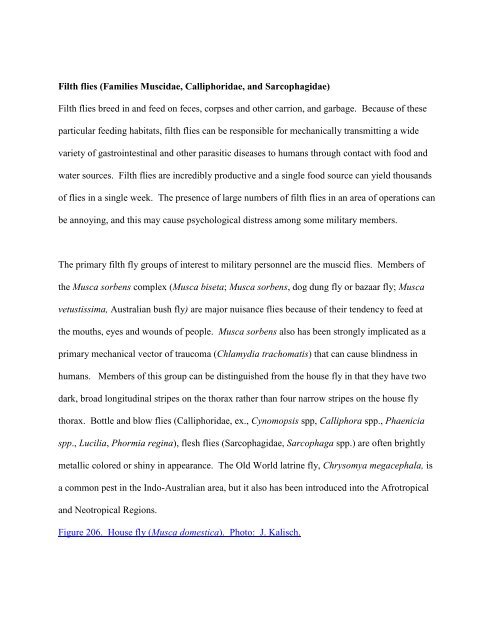Field Guide to Venomous and Medically Important Invertebrates ...
Field Guide to Venomous and Medically Important Invertebrates ...
Field Guide to Venomous and Medically Important Invertebrates ...
You also want an ePaper? Increase the reach of your titles
YUMPU automatically turns print PDFs into web optimized ePapers that Google loves.
Filth flies (Families Muscidae, Calliphoridae, <strong>and</strong> Sarcophagidae)<br />
Filth flies breed in <strong>and</strong> feed on feces, corpses <strong>and</strong> other carrion, <strong>and</strong> garbage. Because of these<br />
particular feeding habitats, filth flies can be responsible for mechanically transmitting a wide<br />
variety of gastrointestinal <strong>and</strong> other parasitic diseases <strong>to</strong> humans through contact with food <strong>and</strong><br />
water sources. Filth flies are incredibly productive <strong>and</strong> a single food source can yield thous<strong>and</strong>s<br />
of flies in a single week. The presence of large numbers of filth flies in an area of operations can<br />
be annoying, <strong>and</strong> this may cause psychological distress among some military members.<br />
The primary filth fly groups of interest <strong>to</strong> military personnel are the muscid flies. Members of<br />
the Musca sorbens complex (Musca biseta; Musca sorbens, dog dung fly or bazaar fly; Musca<br />
vetustissima, Australian bush fly) are major nuisance flies because of their tendency <strong>to</strong> feed at<br />
the mouths, eyes <strong>and</strong> wounds of people. Musca sorbens also has been strongly implicated as a<br />
primary mechanical vec<strong>to</strong>r of traucoma (Chlamydia trachomatis) that can cause blindness in<br />
humans. Members of this group can be distinguished from the house fly in that they have two<br />
dark, broad longitudinal stripes on the thorax rather than four narrow stripes on the house fly<br />
thorax. Bottle <strong>and</strong> blow flies (Calliphoridae, ex., Cynomopsis spp, Calliphora spp., Phaenicia<br />
spp., Lucilia, Phormia regina), flesh flies (Sarcophagidae, Sarcophaga spp.) are often brightly<br />
metallic colored or shiny in appearance. The Old World latrine fly, Chrysomya megacephala, is<br />
a common pest in the Indo-Australian area, but it also has been introduced in<strong>to</strong> the Afrotropical<br />
<strong>and</strong> Neotropical Regions.<br />
Figure 206. House fly (Musca domestica). Pho<strong>to</strong>: J. Kalisch.

















